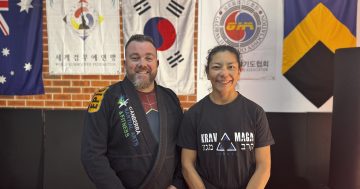I came across a recent judgement by Justice Refshauge in a case where the accused,Joseph Shelvin was on trial for recklessly inflicting grievous bodily harm and assault occasioning actual bodily harm on Wayne Maloney. Shelvin was acquitted on the basis that the Crown had not disproved self-defence beyond reasonable doubt.
The incident occurred on 24 August 2008 at the Holy Grail Kingston where Shelvin was drinking with friends and was approached by Maloney who placed his arms around him in a friendly gesture hugging him.One of Shelvin’s friends,Damon Smith, reacted to the situation by grabbing Maloney by the back of his jacket and forcefully pulled Maloney and inadvertently Shelvin onto the floor.Shelvin then got up and assisted Maloney to his feet.Maloney then remonstrated in a ostensibly non-threatening manner with his hands at waist height to the front and side questioning why Smith was so aggressive. Shelvin then responded by forcefully pushing Maloney in the chest and immediately thereafter punched Maloney in the head with substantial force. Maloney fell backwards and his head impacted with the tiled floor causing significant injury which later required the insertion of a metal plate in his skull.
The decision by Refshauge to find Shelvin not guilty of the charges prompted me to email Attorney General Corbell drawing to his attention that had Maloney died as a result of the assault then based on Refshauge’s reasoning Shelvin would have been entitled to be acquitted of a potential murder charge. I referred to the decisions in James Cook, Mauricio Rao, Russell Field and Cameron Anderson’s killer which had similarities to case studies where excessive self-defence was judged to have occurred.Corbell’s response was to claim that if the conduct of a defendant was not a reasonable response to the circumstances they found themselves in then they may be found guilty of murder. My response to Corbell was to point to the High Court decision in Zecevic(1987) which Chief Justice Higgins applied in his judgements in Rao,Field and Anderson’s killer.I then received a response from Chief Minister Gallagher who said that it was her understanding that the introduction of excessive self defence would not have addressed my concerns and that the ACT was not considering adopting the partial defence to murder at this time.
Obviously, I strongly disagree and here’s why: In the High Court decision in Zecevic(1987) which became common law in self defence, the majority by 5 to 2 said that the question to be asked in the end is quite simple, it is whether the accused believed upon reasonable grounds that it was necessary in self defence to do what they did. If they had that belief and there were reasonable grounds for it then they were entitled to an acquittal. Further to this they also indicated that the issue of self defence should be approached in a practical manner and without undue nicety,giving proper weight to the predicament of the accused which may have afforded little,if any,opportunity for calm deliberation or detached reflection.The new formulation effectively abolished the partial defence of excessive self defence and it’s worth noting that Deane J strongly dissented in Zecevic believing that the abolition of the partial defence was unjust and that it was wrong to retrospectively abolish a defence. The backflip from the previous decision in Viro(1978), which was considered too complicated, meant that Higgins and Crispin,in applying the new formulation, could justifiably acquit those I refer to above. The simple reality is that the Crown didn’t stand a chance of disproving self defence given the new formulation.
In 1997 South Australia amended their self defence laws to include excessive self defence. In 2002 NSW also reintroduced excessive self defence. The provision is as follows: if a person uses force that involves the infliction of death, and the conduct is not a reasonable response in the circumstances as he or she perceives them, but the person believes the conduct is necessary to defend themselves then they are guilty of manslaughter.Victoria introduced defensive homicide in 2005,which while similar to excessive self defence,was introduced to reduce the offence of murder to manslaughter in cases where women were subjected to continued physical abuse from their partners who they killed fearing for their lives. Unfortunately since it was introduced only two of the 19 convictions for defensive homicide have involved female defendants which has prompted the AG to introduce amendments to the legislation.In 2008 Western Australia removed provocation as a partial defence and introduced excessive self defence.
For the benefit of Gallagher and Corbell I will briefly detail what occurred in R v Cook and why he was IMO guilty of excessive self defence. I should firstly point out that Cook was arraigned before Gray J on a single count of murder and entered a plea of manslaughter which the Crown, rightfully, accepted. The proceedings were listed before Higgins for sentencing who rejected the plea finding the facts didn’t support manslaughter ie. he realised that under the new formulation Cook would be acquitted on the basis of self defence so he disqualified himself and handed the baton to Crispin.
The brief facts are as follows: In December 2003 James Cook who lived opposite Daniel Beck at the Southside Caravan Park socialised with Beck during which time they consumed a significant amount of alcohol. Shortly after their drinking session Beck provoked Cook into a physical confrontation during which time Cook got the upper hand while they were wrestling and then strangled Beck to death. Cook actually said that he continued to choke Beck for almost 30 seconds after Beck went limp. There is absolutely no doubt in my mind that while it’s clear that Cook was defending himself he simply took it too far and his response was excessive. Unsurprisingly Crispin determined that the Crown did not disprove that he acted in self defence, beyond reasonable doubt, so he was acquitted.
The question, therefore, that the Chief Minister and the Attorney General need to ask themselves is whether they still consider excessive self defence unnecessary given the abovementioned circumstances and the potential for this type of scenario to rear its ugly head, yet again. While anyone accused of murder would now be tried by a judge and jury if the accused claimed that he or she acted in self defence the jury would still be bound to consider its verdict according to the principles in the Zecevic formulation.
There is, of course, the other issue whereby it has taken almost 5 years to get a decision in the Shevlin case. So I think it’s appropriate to leave you with the rather extraordinary language used by recently retired High Court Justice Dyson Heydon “A party which has a duty to assist the court in achieving certain objectives fails to do so. A court which has a duty to achieve those objectives does not achieve them. The torpid languor of one hand washes the drowsy procrastination of the other.”
Rather damning, don’t you think Attorney General?
http://www.austlii.edu.au/au/cases/cth/HCA/1987/26.html
http://www.courts.act.gov.au/supreme/judgment/view/6661/title/r-v-shevlin
http://www.courts.act.gov.au/supreme/judgment/view/2805/title/r-v-cook














